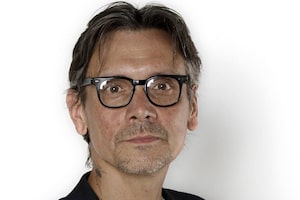Director Alfonso Cuaron says creating Gravity ‘was not a structured process.’Evan Agostini/The Associated Press
When it came to the making of Gravity, a monumentally challenging 3-D movie about a medical engineer (Sandra Bullock) cast adrift in space after debris destroys her shuttle, the operative production metaphor was blindness.
Not only does Bullock's Dr. Ryan Stone anxiously repeat, "Houston! In the blind!" every time she loses her bearings, but Bullock herself cried, "Alfonso! In the blind!" more than once to her director. Alfonso Cuaron was as helpful as he could be under the circumstances, but in the circumstances – Gravity involved levels of technical innovation that were themselves out of this world – he felt in the blind a lot of the time as well.
"It was not a structured process," Cuaron said of the production after taking a seat beside Bullock at a Toronto International Film Festival event last month. "It was more a process of trying to figure things out."
Cuaron wanted the actors to appear not just to float, but to turn and spin as they would in true zero gravity. And he wanted to shoot long, fluid shots with few cuts. Devising how to do both required new technologies and techniques, including the use of a cube surrounded by LED lights into which Bullock would be strapped and attached to a wire puppeteering system.
Alone throughout most of the movie, Bullock was herself stranded in a studio, compelled to create a credibly emotional and convincingly physical performance in a complete vacuum. Most of Gravity's production had yet to be mounted at the time she was pretending to be floating in space, and all she had to go on was the vision of her director and his army of technicians. She was relying as intensely on the director's voice in her headset as her character depends on the voices coming from Houston (Ed Harris) and her fellow stranded astronaut (George Clooney).
Bullock's challenge was to bring the character's emotional desperation to life.
"Basically," she explained, "they would show you a little video, an anime version that was like, 'Okay she's doing this, she's doing this and she's grabbing onto here, and then her legs swing up,' and you have to turn and you have to grab here. That's about eight seconds and that's all you get. You can't look left and right. You had a little bit of leeway in the helmet, but your body had to match exactly what they were doing."
So what made it worth it? Why enter reputation-risky and uncharted technical and creative territory for the sake of a movie?
"Every single day I asked that question," Cuaron responds with a rueful grin. "Every single day. But the truth of the matter was that, for me, it was easy. I was walking around saying, 'Sandy, can you do it slower?' The fact is, Sandra trained so much and rehearsed so much that, when we were shooting, we rarely discussed technical aspects. Most of the time we were just talking about performance. Performance and emotion. That was the constant concern, the constant preoccupation."
The actor and director spent hours discussing the big existential themes Cuaron wanted the film to address – it was based on a script he co-wrote with his son Jonas – so that a strong and clear emotional foundation was laid. For Bullock, the process helped relieve some of the blindness, but she still depended on the director to keep her anchored during those moments when the process too closely resembled her character's predicament.
"You find sort of a kindred spirit," Bullock says. "I was like, 'I don't know how this is going to work. I don't know if I'm going to be able to make it work. What do I have to offer? I don't know.' But he knew in his head what he wanted to say. I knew that we agreed on major life points in what we wanted to say in this."
The result is a truly unusual Hollywood achievement: an intimate blockbuster, a personal story as vast as space, a story of the human spirit played out against a backdrop empty of humanity.
And that achievement is built in part on Bullock's willingness to follow Cuaron's directions, even when she had no way of knowing where they would lead. "I just had to trust in what he saw," she says, "because I saw nothing, I heard nothing."
 Geoff Pevere
Geoff Pevere